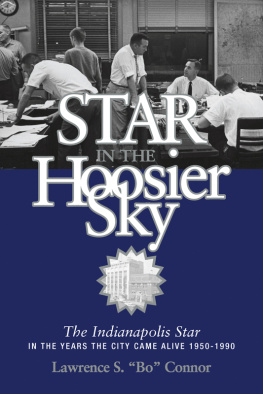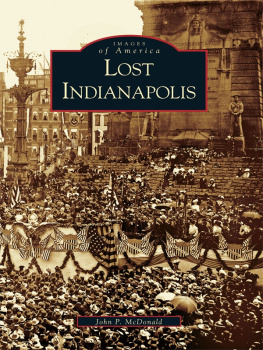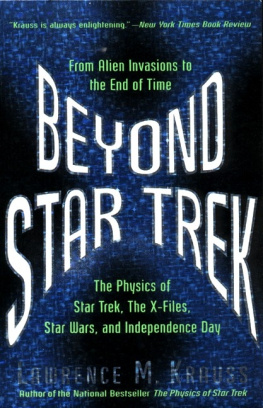About the author....
Lawrence S. (Bo) Connor began his forty-one-year career at The Star in 1949 as a police reporter and retired in 1990 as managing editor. He worked in nearly every editorial position on the paper, including a three-month stint as editor of the editorial page. He served three years in the Army Air Corps during World War II and began work at The Star after graduating from the University of Notre Dame in 1949. He and his wife, Patty, are the parents of six children and grandparents of 15. They live in Indianapolis. This is Connors second book. Hampton Court, Growing up Catholic in Indianapolis between the Wars was published in 1994 by Guild Press of Indiana.
Star in the Hoosier Sky may be ordered directly from:
www.hawthornepub.com
or
317-867-5183
Acknowledgments
I wish to thank the following persons for their assistance in writing this book: Edward H. Frank, R. Joseph Gelarden, Max Friedersdorf, Richard R. Roberts, Richard E. Cady, R. K. Shull, Myrta Pulliam, Jerry Clark, John H. Lyst, James D. Mitchell, Joseph Hallinan, Susan Headden, James Young, Carolyn Lautner, Gloria Keating, Donna Mullinix, Lee Giles, Forest Bowman, Leroy K. New, Carl Henn, Frank Fisse, Mac Trusnik , Becky Walter, Tridi Poston and especially for my wife, Patty, and daughter, Carrie Weigel.
Special appreciation to The Indianapolis Star
which granted persmission to use its archival photos and articles.
If a movie producer had wanted to film yet another remake of The Front Page the city room of The Indianapolis Star in the 1950s would have been an ideal setting. The place was crowded, noisy, and dingy. Cigarette butts and copy paper littered the linoleum-covered floor. Editors yelled at copy boys. Teletype machines hummed while turning out copy from the wire services, and reporters pounded out stories on Royal typewriters. Just about everyone smoked. By six oclock when the staff was working on the first (or bulldog) edition, a haze hung over the newsroom.
There was always a shortage of desks, so most of the young reporters shared them. They were wooden with typewriter wells sunk in the middle, all of them scarred with cigarette burns. We were instructed to close up the desks at the end of each day, but few of us bothered. Desks were piled with notes, press releases, magazines, stacks of copy paper and half-filled paper coffee cups. Periodically the managing editor would issue an order to clean off the desktops. Two days later the piles returned.
I became part of that raucous newsroom in November of 1949. It was a place I had wanted to be since I was a boy. The meager pay ($42.50 a week) didnt dampen my enthusiasm, at least at that time. As a kid I loved movies about newspapers, getting a thrill out of watching Joel McCrea break the big story in Foreign Correspondent , and watching the wily managing editor, Walter Burns, manipulate ace reporter Hildy Johnson in The Front Page . I even liked the B-movies where brash reporters sported press passes in their hatbands.
I grew up in Hampton Court, an apartment complex a mile and a half north of The Star building. In the summer of 1937 several of the youngsters living in the apartments published three issues of a newspaper we first called the Hampton Sentinel and then switched to The Court Reporter. It carried items about what was happening in the court. I loved looking at the paper after my dad had it printed where he worked.
But I didnt seriously consider journalism when I returned from three years in the Army Air Corps. Before I headed off to the University of Notre Dame, thanks to the G I Bill, I received some valuable advice from an uncle. I told him I thought I should take courses that promised better pay, mentioning that hotel and restaurant management was being touted as a lucrative field. He nixed that idea. He said that he traveled a lot and observed that hotel managers were faced with crises almost daily. Asked what I wanted to do, I told him Id like to work on a newspaper but heard that the pay was meager.
Do what you like, he said. Dont worry about the money. Youll make a decent living, adding, Ive been an accountant all my life and hated every minute of it. So I took his advice and majored in journalism, though in the mid-1940s it had a grander titlecommunication arts.
I felt fortunate to be hired because so many ex-servicemen had been returning to the paper. The fact that my mother had worked with the papers editor, Jim Stuart, in the first decade of the century probably helped in my being hired. There were no writing or reporting tests. It all depended upon whether there was an opening on the staff and the city editor thought you had possibilities
It was all true about the lousy hours and the poor pay, but that didnt matter. I was just happy to have joined an assortment of colorful, irreverent and talented men and women in a profession that to me held the promise of excitement nearly every day.
When I was hired , The Star wasnt much of a newspaper, but most of the other medium-sized papers didnt have much going for them either. On most days The Star ran 24 to 28 pages split into two sections. Any advertising was inside the paper; the colorful inserts on slick paper arrived years later.
Like the rest of the city, the paper was recovering from the Depression and World War II. Throughout the war years, the paper printed an abundance of wire copy, mostly war news. The staff operated with a few decent reporters and a support crew of aged and uninspired reporters and copy editors, many with alcohol problems. Few of the older breed had college degrees. But many of them helped me learn the business both on the job and at bars and all-night eateries after we had left the building for the night.
The half dozen women who comprised the society department spent their time typing up wedding announcements and listing social events. Fashions and home furnishings stories went in the Sunday paper.
Corbin Patrick, who chronicled and promoted the citys cultural growth for more than 60 years, reported the citys meager arts and cultural scene. He joined the paper in 1925 and was named drama critic in 1941. He estimated that he reviewed 5,000 plays. Pat managed to find something redeeming in every show, especially local amateur productions. He was instrumental in gaining support for a symphony orchestra, the Ensemble Music Society and Clowes Hall. He was still interested in what was going on at the paper and in the entertainment scene until he died at age 97 in 2002.
Television became part of his bailiwick, but only after the publisher had to acknowledge that ignoring TV wasnt working. Eventually, Corbin was able to hire an assistant and a woman to prepare the television grids. By then TV Guide was becoming the largest selling magazine in the U. S. The papers art columnist, Lucille Morehouse, wrote her Sunday column in her Irvington home. A couple of times I was sent to her house to pick up her copy. Either her house lacked electricity, or she shunned it, because the rooms were illuminated with candles.
Gordon Milne was the garden editor. He spent most of his time answering calls from readers about the best times to plant petunias and how best to get a healthy lawn. Gordon was resourceful. He kept his Sunday columns in a file cabinet by his desk. When it was time to write the column, he would extract last years column from the cabinet, mark it up and send it to the composing room. Why not, he reasoned; the advice from year to year was always the same. Gordon was the closest thing to a specialist on the staff.
The paper concentrated on politics, government and police news. Little attention was paid to education, religion and medical matters. If there was an Indianapolis School Board meeting that night, the city editor would look around for whoever might be available to cover it. The church editor confined her efforts to gathering short items about Sunday services. They covered the top half of the Saturday church page; the bottom half was devoted to ads about churches and ministers.
Next page








